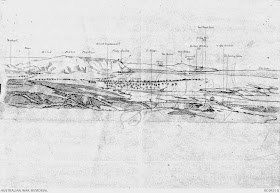The ANZACs who found themselves ashore at Gallipoli on April 25 soon realized that they were unable to get beyond the landing beaches due to strong Turkish positions on the ridgeline above, and they were subjected to constant shelling from artillery beyond the protective ridge.
 |
| Some ANZAC names (Wikipedia) |
One such named location was "the Olive Grove," in a plain near Gaba Tepe, where a well-concealed Turkish artillery position was set up in a place from which it had a clear view of the ANZAC beaches. It could shell the beachhead at will and regularly did so, also dropping shells and shrapnel offshore where the ANZAC troops regularly swam to escape the heat of the Aegean summer.
The Olive Grove position first came into action 100 years ago today. It would be a persistent threat to the beachhead right up to withdrawal months later, which took place under its gunnery. The Australian and New Zealand troops not only named the Olive Grove, they named the gun.
They called it "Beachy Bill."
According to the Australian National University website, "Glossary of Slang and Peculiar Terms in Use in the A.I.F":
Beachy Bill The Turkish guns emplaced in the Olive Grove (Gallipoli) which caused considerable casualties at Anzac, mostly on the beaches.
World War I. 1915 (Partridge). Attested in F&G and Partridge.
While Partridge does not note this as specifically Australian, ‘Beachy Bill’ clearly has special relevance to the Australian experience of the war.
They never got to meet him up close, but certainly felt his presence. (They speak generally of a single gun, though other guns in the vicinity contributed.) "Beachy" presumably refers to its threat to, and nearness to, the beaches.There’s a certain darned nuisance called ‘Beachy,’Whose shells are exceedingly screechy;But we’re keeping the score,And we’re after your gore –So look out, ‘Beachy Bill,’ when we meet ye.1916 ANZAC Book, p. 96.
From a Turkish website about Gallipoli, quoting a British source:
According to the unknown author of a 1917 publication, The Story of the Anzacs, ‘ On an average, “Beachy “ is said to have accounted for twelve men a day.’ Whether ‘ accounted for’ meant killed or killed and wounded is not clear; but an average of twelve men a day over eight months, added to nearly 3,000 casualties, which was not a bad score even if it included wounded. B Depot made its contribution, most of the casualties being amongst the infantry fatigue parties who were men ‘resting’ from the front line.
According to a letter to the Editor of the Western Mail (Perth), Thursday 28 December 1933, page 2, as cited by the Australian Light Horse Studies Centre, they tried quite hard to silence the position, including naval shelling. (The writer refers to the "Olive Grove" as the "Orange Grove," perhaps due to a trick of memory:)"These Things Happened", (Melbourne 1975), F.F. Knight, p. 147
Unless Australian soldiers' vocabulary has changed dramatically in 100 years, which I rather doubt, I would assume that "was seldom referred to in complimentary terms" probably means the name was usually preceded by some rather pungent adjectives particularly popular down under. Particularly the one beginning in "f" and ending in "ucking." (I believe someone once called it "the great Australian adjective," though it's hardly unfamiliar to Brits and Amricans.)
The Australian War Museum has a sketch, "View Southward from Anzac Position to Olive Groves" that shows the position with the Kilid Bahr ridge rising behind. The artillery concealed in the grove could shell the beach:
The 7th Light Horse Regiment revisited the battlefield in 1918 after serving in Gallipoli and Palestine, and the Australian Light Horse Studies Centre offers an excerpt from their official history about the Olive Grove and Beachy Bill:
Lieutenant Colonel John Dalzell Richardson produced a unit history published in 1919 called The History of the 7th Light Horse Regiment AIF which included a section specifically related to the battle of Beersheba and is extracted below.
Richardson, JD, The History of the 7th Light Horse Regiment AIF, Sydney, 1919, pp. 107 - 113:
CHAPTER VII.
THE OLD BATTLE-FIELDS . . .
The hill system of Anzac, which culminates in the height of Chunuk Bair to the north, slopes gradually downwards in undulating ridges almost to sea level at Cape Helles-the height of Achi Baba being the one outstanding feature, not far from the village of Krithia. But between the village of Maidos on the Straits and the headland of Gaba Tepe lies a level plain of no great width, and on the side farthest from Anzac is the famous "Olive Grove," from which Beachy Bill used to fire with such deadly results. The enemy position, known as Pine Ridge, on the right flank, looks down on this plain, and the gully held by the Turks at the eastern end of Lone Pine opens into it. If this gully and the ridge beyond, as well as Pine Ridge, could have been taken, the valley would have been open for an advance at any time as far as the Kilid Bahr Plateau without any natural obstacle.Finally, a modern photo of the former site of a gun emplacement at the Olive Grove:





No comments:
Post a Comment